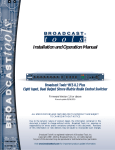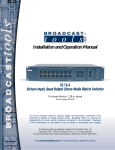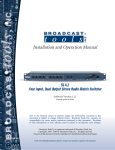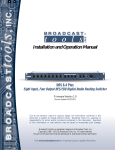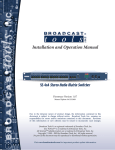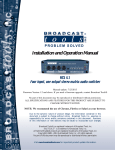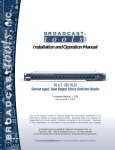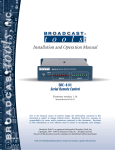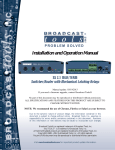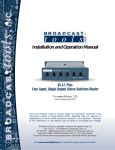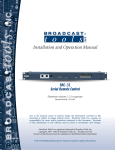Download Broadcast SS 16.2 Specifications
Transcript
INC ® P R O B L E M S O LV E D Installation and Operation Manual ACS 16.2 Sixteen Input, Dual Output Stereo Audio Matrix Switcher Manual update: 5/5/2014 Firmware Version 1.6 If you need a firmware upgrade, contact Broadcast Tools® No part of this document may be reproduced or distributed without permission. ALL SPECIFICATIONS AND FEATURES FOR THIS PRODUCT ARE SUBJECT TO CHANGE WITHOUT NOTICE NOTE: We recommend the use of Chrome, Firefox or Safari as your browser. Due to the dynamic nature of product design, the information contained in this document is subject to change without notice. Broadcast Tools, Inc., assumes no responsibility for errors and/or omissions contained in this document. Revisions of this information or new editions may be issued to incorporate such changes. Broadcast Tools® is a registered trademark of Broadcast Tools, Inc. tiny TOOLS™ is a trademark of Broadcast Tools, Inc. All Sentinel® labeled products are registered trademarks of Broadcast Tools, Inc. Copyright® 1989 - 2014 by Broadcast Tools, Inc. All rights reserved. No part of this document may be reproduced or distributed without permission. Visit www.broadcasttools.com for important product update information. ACS 16.2 Installation and Operation Manual Table of Contents Section Title Page # Introduction. . . . . . . . . . . . . . . . . . . . . . . . . . . . . . . . . . . . . . . . . . . . . . . . . . . . . . . . . . . . . 2 Safety Information . . . . . . . . . . . . . . . . . . . . . . . . . . . . . . . . . . . . . . . . . . . . . . . . . . . . . . . 2 Who to Contact for Help . . . . . . . . . . . . . . . . . . . . . . . . . . . . . . . . . . . . . . . . . . . . . . . . . . 2 Product Description . . . . . . . . . . . . . . . . . . . . . . . . . . . . . . . . . . . . . . . . . . . . . . . . . . . . . . 3 Features . . . . . . . . . . . . . . . . . . . . . . . . . . . . . . . . . . . . . . . . . . . . . . . . . . . . . . . . . . . . . . . . 3 Function Guidelines . . . . . . . . . . . . . . . . . . . . . . . . . . . . . . . . . . . . . . . . . . . . . . . . . . . . . . 4 Front Panel Description . . . . . . . . . . . . . . . . . . . . . . . . . . . . . . . . . . . . . . . . . . . . . . . . . . . 4 Rear Panel Description . . . . . . . . . . . . . . . . . . . . . . . . . . . . . . . . . . . . . . . . . . . . . 4 Front Panel Knobs/Switches . . . . . . . . . . . . . . . . . . . . . . . . . . . . . . . . . . . . . . . . . 4 Front Panel LED indicators . . . . . . . . . . . . . . . . . . . . . . . . . . . . . . . . . . . . . . . . . . 4 Audio Inputs . . . . . . . . . . . . . . . . . . . . . . . . . . . . . . . . . . . . . . . . . . . . . . . . . . . . . 4 Audio Outputs . . . . . . . . . . . . . . . . . . . . . . . . . . . . . . . . . . . . . . . . . . . . . . . . . . . . 5 Silence Sensors . . . . . . . . . . . . . . . . . . . . . . . . . . . . . . . . . . . . . . . . . . . . . . . . . . . 5 PIP (GPI/Trigger)/Remote Control Inputs. . . . . . . . . . . . . . . . . . . . . . . . . . . . . . . 5 Open Collector Status Outputs . . . . . . . . . . . . . . . . . . . . . . . . . . . . . . . . . . . . . . . 5 Relay Outputs . . . . . . . . . . . . . . . . . . . . . . . . . . . . . . . . . . . . . . . . . . . . . . . . . . . . 5 RS232 Serial Port . . . . . . . . . . . . . . . . . . . . . . . . . . . . . . . . . . . . . . . . . . . . . . . . . 6 User Programming . . . . . . . . . . . . . . . . . . . . . . . . . . . . . . . . . . . . . . . . . . . . . . . . . . . . . . . 6 Installation Guidelines . . . . . . . . . . . . . . . . . . . . . . . . . . . . . . . . . . . . . . . . . . . . . . . . . . . . . Inspection . . . . . . . . . . . . . . . . . . . . . . . . . . . . . . . . . . . . . . . . . . . . . . . . . . . . . . . . . . . . . . 7 Setting “OPTION” Dipswitches . . . . . . . . . . . . . . . . . . . . . . . . . . . . . . . . . . . . . . . . . . . . . 7 Power-Up Feature . . . . . . . . . . . . . . . . . . . . . . . . . . . . . . . . . . . . . . . . . . . . . . . . . . . . . . . . 7 Mounting. . . . . . . . . . . . . . . . . . . . . . . . . . . . . . . . . . . . . . . . . . . . . . . . . . . . . . . . . . . . . . . 8 Power Supply Connection . . . . . . . . . . . . . . . . . . . . . . . . . . . . . . . . . . . . . . . . . . . . . . . . . 8 Connecting the Audio Inputs and Outputs . . . . . . . . . . . . . . . . . . . . . . . . . . . . . . 8 Audio Input and Output Level Adjustment . . . . . . . . . . . . . . . . . . . . . . . . . . . . . . 9 Connecting the PIP (trigger) inputs . . . . . . . . . . . . . . . . . . . . . . . . . . . . . . . . . . . . . . . . . . 9 Connecting relay outputs . . . . . . . . . . . . . . . . . . . . . . . . . . . . . . . . . . . . . . . . . . . . . . . . . 10 Connecting open collector outputs . . . . . . . . . . . . . . . . . . . . . . . . . . . . . . . . . . . . . . . . . . 10 Connecting to the RS-232 serial port . . . . . . . . . . . . . . . . . . . . . . . . . . . . . . . . . . . . . . . . 13 Connecting two units to one serial port . . . . . . . . . . . . . . . . . . . . . . . . . . . . . . . . . . . . . . 13 WEBSITE: Visit our web site for product updates and additional information. Operation Guidelines Front Panel LEDs . . . . . . . . . . . . . . . . . . . . . . . . . . . . . . . . . . . . . . . . . . . . . . . . 14 Front Panel operation. . . . . . . . . . . . . . . . . . . . . . . . . . . . . . . . . . . . . . . . . . . . . . 14 Serial Control . . . . . . . . . . . . . . . . . . . . . . . . . . . . . . . . . . . . . . . . . . . . . . . . . . . . . . . . . . 15 Serial Burst Mode Commands . . . . . . . . . . . . . . . . . . . . . . . . . . . . . . . . . . . . . . . . . . . . . 16 Set-up Commands. . . . . . . . . . . . . . . . . . . . . . . . . . . . . . . . . . . . . . . . . . . . . . . . . . . . . . . 16 Specifications . . . . . . . . . . . . . . . . . . . . . . . . . . . . . . . . . . . . . . . . . . . . . . . . . . . . . . . . . . 17 Warranty . . . . . . . . . . . . . . . . . . . . . . . . . . . . . . . . . . . . . . . . . . . . . . . . . . . . . . . . . . . . . . 20 Component Layout . . . . . . . . . . . . . . . . . . . . . . . . . . . . . . . . . . . . . . . . . . . . . . . . Appendix CONTENTS e-mail: [email protected] voice: 360.854.9559 fax: 866.783.1742 2 ACS 16.2 Installation and Operation Manual INTRODUCTION Thank you for your purchase of a Broadcast Tools® ACS 16.2 Sixteen Input, Dual Output Stereo Audio Matrix Switcher (referred to as the ACS 16.2 throughout this manual). We’re confident that this product will give you many years of dependable service. This manual is intended to give you all the information needed to install and operate the Broadcast Tools® ACS 16.2. SAFETY INFORMATION Only qualified personnel should install Broadcast Tools® products. Incorrect or inappropriate use and/or installation could result in a hazardous condition. CAUTION! Broadcast Tools® Products, as with any electronic device, can fail without warning. Do not use this product in applications where a life threatening condition could result due to failure. WHO TO CONTACT FOR HELP If you have any questions regarding your product or you need assistance, please contact your distributor from whom you purchased this equipment. If you would like more information about BROADCAST TOOLS® products, you may reach us at: NOTE: This manual should be read thoroughly before installation and operation. Broadcast Tools, Inc. 131 State Street Sedro-Woolley, WA 98284-1503 USA Voice: 360.854.9559 Fax: 866.783.1742 Internet Home Page: www.broadcasttools.com E-mail:[email protected] THANK YOU FOR CHOOSING BROADCAST TOOLS® BRAND PRODUCTS! WEBSITE: Visit our web site for product updates and additional information. INTRODUCTION e-mail: [email protected] voice: 360.854.9559 fax: 866.783.1742 3 ACS 16.2 Installation and Operation Manual Product Description The Broadcast Tools® ACS 16.2 provides matrix audio switching of 16 stereo inputs to two stereo outputs. Matrix switching allows any/or all inputs to be assigned to any/or all outputs with inputs one and two having fade and dim capabilities. The ACS 16.2 may be controlled via front panel channel selection knob and take push button, contact closures, open collectors, logic and/or the multi-drop RS-232 serial port (USB or Ethernet optional). Installation is simplified with plug-in euroblock screw terminals. FEATURES • Channel selection knob for input selection for both outputs, along with the front panel “take” push button. • Three audio switching modes; interlock, overlap and mix. • Inputs one and/or two audio for output one can be faded and/or dimmed via serial commands. • Internal stereo silence sensors monitor each output. The ACS is equipped with front panel silence sensor LED indicators; independent SPDT alarm relays and adjustable SS alarm delay and restore timing duration. • Stereo LED VU meters with front panel output selection switch. • Built-in stereo headphone amplifier with front panel output selection switch, headphone jack and level control. • Power-up selection of inputs to outputs, mute or last source selected. • Most configuration options set via rear panel dipswitches. • 16 input “PIP” (GPI / Trigger) port (or remote control) with front panel “PIP” LED indicator. • 16 open collector outputs configurable for inputs status tallies or computer control. • Eight SPST (NO) relays. • Front panel multi-turn input trimmers. • Internal output level adjustments trimmers. • Electronically balanced stereo inputs and outputs with low noise and distortion circuitry. • Multi-drop RS-232 serial port (OPTIONAL USB and/or Ethernet adapters) with power and data activity LED’s. • Plug-in euro block screw terminals for ALL audio I/O and remote control connections. • 1-RU aluminum enclosure. • Surge protected external universal switching power supply (100 - 240 VAC / 50/60 Hz input) with IEC input plug with domestic AC power cord. DESCRIPTION e-mail: [email protected] voice: 360.854.9559 fax: 866.783.1742 4 ACS 16.2 Installation and Operation Manual FUNCTION DESCRIPTION Front Panel The ACS 16.2 is a 1-rack unit device (19”w x 1.75”h x 10”d). The front panel includes a channel selection knob, channel “take” push button, input level trimmers, I/O and function LED indicators, headphone and LED VU meter selection switch, ¼” T/R/S headphone jack and level control. Rear Panel Installation is simplified with plug-in euro block screw terminals. The rear panel hosts the input and output connectors, “OPTIONS” Dip-switch, multi-drop RS-232 modular connector, chassis ground screw and 5-pin DIN universal power supply connector. Front Panel Knobs/Switches The front panel of the ACS 16.2 contains one channel selection knob and a “TAKE” push button for input to output selection, a monitor selection switch, for which LED indicators are also present. The front panel also houses the input level controls and stereo VU meter and headphone jack/volume control. The input channels may be configured for the following switching modes using the Options dip-switch: • Overlap - Overlap one audio source with another while the button for the second source is held down. Both channels will be fed to the output until the TAKE button is released, at which time the first audio source will be switched off. • Mix - More than one input at a time may be connected to any given output - Push the TAKE button once to connect input, then press again to disconnect. • Interlock - Connecting one input to any output disconnects all other inputs from that output Front Panel LED Indicators The ACS 16.2’s front panel LED indicators provide operational display of the following information: • “Output One” LEDs 1-16: Lit to indicate a given input channel is routed to output one. • “Output Two” LEDs 1-16: Lit to indicate a given input channel is routed to output two. • “PWR/HB” LED: Illuminates when power is applied and blinks when serial data is active. • “PIP” LED: Flashes to indicate PIP activity. • “SS-1” and “SS-2” LEDs: Silence Sensor indicators for output one and output 2, lit when silence is detected. The silence sensor must be enabled for this to function. • “OP2” LED: Lit when output two is selected for VU metering/headphone monitoring. WEBSITE: Visit our web site for product updates and additional information. Audio Inputs Each of the sixteen stereo inputs are balanced bridging (20KΩ, depending on the position of the trimmer) at a nominal line level of +4dBu. Front panel multi-turn level trimmers are provided for each channel. Inputs 1 and 2 can faded up, faded down or dimmed when routed to output 1 when using serial control commands. DESCRIPTION e-mail: [email protected] voice: 360.854.9559 fax: 866.783.1742 5 ACS 16.2 Installation and Operation Manual Audio Outputs The ACS 16.2 provides two balanced low impedance stereo outputs. The output level may be adjusted with internal single turn trimmers. Silence Sensors The ACS 16.2’s outputs have built-in silence detectors that monitors the sum each stereo channel. The factory default delay is set at 10 seconds, with a threshold of -30 dB, while the restore time is set at 2 seconds. Upon silence detection the “SS-1” and/or “SS-2” LEDs light along with the “SS1” and/or “SS2” relays will activate for the duration of the silence. Serial data is also sent on the loss and restoration of audio. The sensors may be programmed for: • Silence sense threshold. The audio level below which is consider silence. This may be set to -20 dBu, -25 dBu, -30 dBu or -35 dBu. • Number of seconds of silence that must be present before an alarm state is reached (Acquire delay.) • Number of seconds that valid audio must be present before an alarm state is cleared (Restore delay). PIP (GPI/Trigger)/Remote Control Inputs The ACS 16.2 has 16 status inputs that may be configured for PIP (“triggers”) or remote control operation. The status inputs accept momentary contact closures to ground, open collectors or TTL/CMOS input logic levels. Open Collector Status Outputs The ACS 16.2 provides sixteen open collector status outputs. The status outputs may be configured to operate in one of three modes: • The status outputs follow the associated channel. • The status outputs a one-second pulse when the associated channel is selected. • Software control Relay Outputs The ACS 16.2 contains eight SPST (normally open) relays. Each relay may be latched on, latched off or momentarily turned on using serial commands. The “pulse” time may be set from 100 msec to 9.9 seconds. The default pulse length is one-second. Alternately, the relays may be set for “MPX” mode. In the “MPX” multiplex mode, the relay follows the associated input channel assigned to output two. DESCRIPTION e-mail: [email protected] voice: 360.854.9559 fax: 866.783.1742 6 ACS 16.2 Installation and Operation Manual RS232 Serial Port The AC 16.2’s serial communication is supplied with a multi-drop RS-232 port, allowing up to four ACS 16.2’s on the same computers serial port. Commands may be entered either via a menu (with unit ID 0 only) (menu mode) or a short form code (ASCII serial string-burst mode). The command to enter menu mode is: *0MM. The menu mode displays certain parameters, and allows for the control and/or configuration of most switcher functions. All commands and responses use normal ASCII characters, facilitating scripting. A burst mode command starts with an asterisk (*) followed by the device (ID) address as a single decimal digit, then the command. User Programming The ACS 16.2 programming is stored in non-volatile memory. Configuration is set with selection dipswitches and computer commands. WEBSITE: Visit our web site for product updates and additional information. DESCRIPTION e-mail: [email protected] voice: 360.854.9559 fax: 866.783.1742 7 ACS 16.2 Installation and Operation Manual INSTALLATION GUIDELINES Inspection Please examine your ACS 16.2 carefully for any damage that may have been sustained during shipping. If any is noted, please notify the shipper immediately and retain the packaging for inspection by the shipper. The package contains the ACS 16.2, universal input, multi-voltage DC switching power supply w/ IEC domestic AC power cord, reversed modular serial cable with the “S9” 9-pin D-Sub adapter. Manuals are downloadable from our web site. Setting “OPTIONS” Dipswitches The ACS 16.2 is equipped with an 8-position “OPTIONS” dipswitch. The dipswitch specifies 2-bit unit ID, baud, audio modes (mix, interlock, overlap), and other features listed below. Access to this switch is on the rear panel. Follow the description below. “OPTIONS” Dipswitch Functions Switch Number 1 2 3 4 5 6 7 8 Default Setting OFF OFF OFF OFF OFF OFF OFF ON Function Binary address 1 (Default ID = 0) Binary address 2 Baud rate (Default) OFF = 9600 / ON = 38400) Stereo Audio Switching (Default = Overlap) Stereo Audio Switching (Default = Overlap) Open Collector and Relay configuration (Default = Burst) Power up modes (Default = Last source selected) Remote Control / “PIP” GPI/Triggers (Default) Address (Unit ID) DIP Switches Switch 1 OFF ON OFF ON Switch 2 OFF OFF ON ON Mode ID = 0 ID = 1 ID = 2 ID = 3 Baud Rate DIP Switch Switch 3 OFF ON Mode 9600 38400 Audio Switch Mode DIP Switches Switch 4 OFF ON OFF ON Switch 5 OFF OFF ON ON Mode Overlap Interlock Interlock MIX INSTALLATION e-mail: [email protected] voice: 360.854.9559 fax: 866.783.1742 8 ACS 16.2 Installation and Operation Manual Open Collector/Relay Mode DIP Switch Switch 6 Function OFF Burst mode control. ON Follow / MUX mode. Power-up Mode DIP Switch Switch 7 Function OFF Last Source Selected ON Use the “Burst” mode serial command *0CPS to store the current selected input/output configuration. Remote / “PIP” (Triggers) Mode DIP Switch Switch 8 Function OFF Remote Control ON “PIP”/Triggers enabled Mounting The ACS 16.2 is designed to be rack mounted in a standard 19” rack. It should be mounted in an area that is accessible from the rear and preferably away from sources of heat. We recommend that you bench test and become familiar with the operation of the ACS 16.2 before permanently installing it. Power Supply Connection Insert the universal AC input, multi-voltage DC switching power supply’s 5-pin DIN connector into the power receptacle on the rear panel of the ACS 16.2. When ready, plug the power supply into the appropriate AC receptacle. M CAUTION! Only use the power supply provided with this product. WEBSITE: Visit our web site for product updates and additional information. CAUTION! Installation of the ACS 16.2 in high RF environments should be performed with care. Shielded cable is suggested for all control, audio inputs and outputs. All audio cable shields should be tied to the “G” terminal on each channel. The station ground should be connected to the chassis ground screw (“Chs Gnd”) located on the right side of the chassis as viewed from the rear. For lightning protection devices, check out www.polyphaser.com and www.itwlinx.com. It is recommended that all cables connected to the ACS 16.2 be looped through ferrite cores to suppress RF. Surge protection with RF filtering such as the Tripp Lite “ISOBAR 4” is also suggested for the power distribution. The use of an uninterruptible power supply (UPS) is highly recommend to provide backup power in case of power outages. INSTALLATION e-mail: [email protected] voice: 360.854.9559 fax: 866.783.1742 9 ACS 16.2 Installation and Operation Manual Connecting the Audio Inputs and Outputs The input channels are numbered from 1 through 16 on the rear panel from RIGHT to LEFT as viewed from the rear. The ACS 16.2 interfaces to your audio equipment through plug-in 5-position euro block screw terminals. Follow the legends on the rear of the unit for the desired audio input and output connections. Before installing a wire, remove the plug-in euroblock screw terminal and turn each capture screw fully counterclockwise. Strip each conductor to a length of 0.25” and insert the conductor fully into the terminal. Turn the capture screw fully clockwise to secure the conductor. The terminals accommodate wire sizes from 16 - 28 AWG solid or stranded wire. Connections should be made to the + and - inputs for balanced operation. For unbalanced inputs connect to the + inputs and connect the – sides to ground using jumper wire. The input impedance is 20KΩ, if 600Ω termination is required, user supplied resistors may be installed on the connector. Connections can be made to the + and - outputs for balanced operation, or to the + output and ground for unbalanced output operation. CAUTION! In no case should either the + or - OUTPUTS be connected to ground on the switcher or an external device. Input 1 (Top row, TB1) 2L2L+ Gnd 2R1L1L+ Gnd 1RInput 2 (Bottom row, TB1) 2R+ 1R+ Audio Input and Output Level Adjustment Once the input and output connections have been made, the input levels can be adjusted. The switcher is factory set for unity. Recommended input levels would be in the range of 0 dBu to +8 dBu. Should input levels need to be changed, trimmers are accessible from the front panel. Each stereo input is labeled and has one trimmer per channel. Connecting the remote control/PIP (trigger) inputs The ACS 16.2’s PIP inputs have two operation modes; PIP (triggers) and remote control. The operation mode is set by the switch number 8 on the Options dipswitch (SW3-8) located on the ACS’s rear panel. When SW3-8 is OFF the unit is in remote control mode and when SW3-8 is ON the unit is in PIP (‘triggers”) mode. The PIP/remote control connections to the switcher are found on the bottom row of the 18-positon euro-block connector TB10. Each channel is pulled high (5-volts) through a 20K resistor and is considered ON when connected to ground (pulled low.) In PIP (“triggers”) mode (SW3-8 ON) the inputs supply status to any serial polling device (when the unit ID is set to 0 (ZERO) no polling of inputs is required). Response time is set for 50ms, but may be configured from 40ms to 2.54 seconds. For information on the PIP serial status commands and syntax refer to the serial burst mode commands section of this manual. In remote control mode (SW3-8 OFF) there are remote control inputs for each of the 16 audio input channels along with an output 2 (OP2) modifier input. If an input channel is off a momentary closure to ground on its remote control input will turn it on for output 1. INSTALLATION e-mail: [email protected] voice: 360.854.9559 fax: 866.783.1742 10 ACS 16.2 Installation and Operation Manual (TB10 Bottom) Remote Control Mode (SW3-8 = OFF) Pin Function Label 1 Input IN 1 2 Input IN 3 3 Input IN 3 4 Input IN 4 5 Input IN 5 6 Input IN 6 7 Input IN 7 8 Input IN 8 9 Input IN 9 10 Input IN 10 11 Input IN 11 12 Input IN 12 13 Input IN 13 14 Input IN 14 15 Input IN 15 16 Input IN 16 15 Input OP2 18 Ground Ground PIP Mode (SW3-8 = ON) Pin Function Label 1 Input PIP 1 2 Input PIP 3 3 Input PIP 3 4 Input PIP 4 5 Input PIP 5 6 Input PIP 6 7 Input PIP 7 8 Input PIP 8 9 Input PIP 9 10 Input PIP 10 11 Input PIP 11 12 Input PIP 12 13 Input PIP 13 14 Input PIP 14 15 Input PIP 15 16 Input PIP 16 15 N/A N/A 18 Ground Ground Connecting relay outputs Eight SPST relays can be used to interface with external equipment using contact closures. The relays may be controlled by serial commands. Each relay may be commanded by serial command to: pulse, latch on, or latch off. The relay connections are located on the top and bottom TB11 terminal blocks. (TB11 Bottom) Pin # Function 1 Output 2 Output 3 Output 4 Output 5 Output 6 Output 7 Output 8 Output Label K1 Normally Open K1 Common K2 Normally Open K2 Common K3 Normally Open K3 Common K4 Normally Open K4 Common (TB11 Top) Pin # Function 1 Output 2 Output 3 Output 4 Output 5 Output 6 Output 7 Output 8 Output Label K5 Normally Open K5 Common K6 Normally Open K6 Common K7 Normally Open K7 Common K8 Normally Open K8 Common WEBSITE: Visit our web site for product updates and additional information. Connecting open collector outputs The ACS 16.2’s open collector outputs have two different operation modes; in burst control mode (SW3-6 OFF) they are control by serial commands, in remote control mode (SW3-6 ON) they provide status for all 16 inputs. The open collector outputs can be used to interface with external equipment. When an open collector output is turn on it will go low providing a return path (ground) for an LED indicator, TTL/CMOS logic or relay. External pull-up resistors may be required in some installations. The open collector connections are located on the top TB10 18-position terminal block. INSTALLATION e-mail: [email protected] voice: 360.854.9559 fax: 866.783.1742 11 ACS 16.2 Installation and Operation Manual (TB10 Top) Pin # Function 1 Output 2 Output 3 Output 4 Output 5 Output 6 Output 7 Output 8 Output 9 Output 10 Output 11 Output 12 Output 13 Output 14 Output 15 Output 16 Output 17 Input 18 Ground Label OC 1 OC 2 OC 3 OC 4 OC 5 OC 6 OC 7 OC 8 OC 9 OC 10 OC 11 OC 12 OC 13 OC 14 OC 15 OC 16 MACRO Ground INSTALLATION e-mail: [email protected] voice: 360.854.9559 fax: 866.783.1742 12 ACS 16.2 Installation and Operation Manual Connecting the RS-232 Serial Port The ACS 16.2 is supplied with a cross-over 4-conductor modular cable and a (S9) 9-pin female D-sub modular adapter for serial control. Only use the modular cord that is supplied with the ACS 16.2 or a replacement that reverses (cross-over), such as Radio Shack Cat No. 279 0347. Connect the cable between the ACS 16.2 and your computers COM port or USB adapter cable (optional). The ACS 16.2 may be serially controlled at baud rates of 9600 or 38400 baud. The unit is shipped set for 9600 baud, with 8 data bits, no parity and one stop bit. ACS 16.2 RJ-11 Adapter Pin 4 DB-9 D-SUB Pin # 3 RS-232 Receive 3 2 RS-232 Transmit 2 5 Ground (Product Point of view) Modular Jack Pin Numbers Connecting Two ACS 16.2’s to a single computer’s serial port Multiple ACS 16.2’s may be cascaded serially to operate from the same serial port. The first step is to assign unit ID’s to each ACS 16.2. One suggestion is to assign unit ID 1 to the first ACS 16.2 and unit ID 2 to the second switcher. The second step is to parallel the serial ports of the ACS 16.2’s. Plug the male end of the duplex modular adapter into the supplied female (S9) DB-9 to RJ-11 adapter, then attach the supplied modular line cords into each of the duplex modular adapter receptacles (Allen-Tel AT202-6) and the other ends into each ACS 16.2 modular receptacles. See the diagram below. WEBSITE: Visit our web site for To ACS 16.2 #1 product updates and additional information. To ACS 16.2 #2 NOTE: Three or more ACS 16.2’s may be daisy chained by using the above description and an Allen-Tel AT150, 5-jack modular adapter. INSTALLATION e-mail: [email protected] voice: 360.854.9559 fax: 866.783.1742 13 ACS 16.2 Installation and Operation Manual OPERATION GUIDELINES ACS 16.2 Front Panel LED’s Front Panel LED’s Input connected to “OP 1” Number Activation Event/Mode Of LED’s 16 Green State of audio connections. Activation Behavior ON if connected Input connected to “OP 2” 16 Red State of audio connections. ON if connected “PWR/HB” 1 Green Valid power and unit operational. ON, but flickers with serial activity. “PIP” (Triggers) input activated. 1 Yellow “SS 1” Silence alarm on output ONE. 1 Red Any valid “PIP” / Trigger input, when Flickers with PIP input activity. enabled. Duration of silence on output ONE. In an alarm condition when ON. “SS 2”, Silence alarm on output TWO. 1 Red Duration of silence on output TWO. In an alarm condition when ON. “OP2”, VU meter and headphone selection. 1 Green When illuminated, the VU meters and ON, Output TWO. OFF, Output ONE. headphone amplifier is monitoring output TWO. ACS 16.2 Front Panel Channel selection knob and Switch operation Action “SELECT” knob. Twist to sequence though inputs one through sixteen for each output. Result Selects the desired input to output. As you twist the knob, the LED will display your input to output position. By pressing the “TAKE” push button, the LED will stop flashing and go solid. The input is now active. Repeat the process to turn an input off. “TAKE” button. Turn inputs on or off. Pressing the “TAKE” when an input is selected using the “SELECT” knob will turn the input on or off for the designated output. “MON SELECT”. Push to toggle between output one and Switches headphone/VU monitoring between output one and two. two monitoring. “HDPH LEVEL”. Adjusts the headphone level. Adjusts the headphone output level. OPERATION e-mail: [email protected] voice: 360.854.9559 fax: 866.783.1742 14 ACS 16.2 Installation and Operation Manual Serial Control The unit is controlled in either Menu or Burst mode. It can run at the following data rates: 9600 Default or 38.4K baud. The ACS 16.2’s serial communication is supplied with a multi-drop RS-232 port, allowing a maximum of four ACS 16.2’s on a single PC’s COM port. Commands may be entered either via a menu (menu mode) or a short form code (ASCII serial string-burst mode). All commands and responses use normal ASCII characters, facilitating scripting. A burst mode command starts with an asterisk (*) followed by the device (ID) address as a single decimal digit, then the command. To control or configure the ACS 16.2 using your PC load a serial terminal application like HyperTerminal or Tera Term and configure the COM port for a protocol of baud: 9600, parity: none, data bits: 8, stop bits: 1, flow control: none, emulation: ANSI. HyperTerminal set up instructions are available on our web site under “Downloads”. The command to enter menu mode is: *0MM. The menu mode displays certain parameters, and allows for the control and/or configuration of most switcher functions. Broadcast Tools(R) ACS16.2, v1.6 - Setup Menu 1 - Set PIP Minimum Hold Time(0 - 2.55 sec) - Now:0.05 2 - Set Relay/OC Pulse Hold Time(0 - 25.5 sec) - Now: 0.5 3 - Set Relay/OC Follow Mode - Now:LATCH:OC SERIAL/RLY SERIAL 4 - Set Silence Sense Acquire Delay (sec) - Now: 10 5 - Set Silence Sense Restore Delay (sec) - Now: 2 6 - Set Silence Sense Thresholds - Now: Off, Off 7 - Lock/Unlock Front Panel - Now:UNLOCKED 8 - Set Audio Fade Rate - Now:1.6 S - Turn ON audio input M - Turn OFF audio V - Save Audio Macro L - Load Audio Macro C - Show Configuration and Status F - Set Factory Defaults WEBSITE: Visit our web site for product updates and additional information. Audio Status: Inputs 1 2 3 4 5 6 7 8 9 10 11 12 13 14 15 16 Output 1 0 0 0 0 0 0 0 0 0 0 0 0 0 0 0 0 Output 2 0 0 0 0 0 0 0 0 0 0 0 0 0 0 0 0 Fade Gain(db): -96.0 -96.0 Enter Selection, or Q to quit: OPERATION e-mail: [email protected] voice: 360.854.9559 fax: 866.783.1742 15 ACS 16.2 Installation and Operation Manual Serial Burst Mode Commands Burst mode allows a computer or ASCII terminal to control and interrogate the unit. This section defines all burst mode commands. Each burst mode commands starts with an asterisk (*). Next is a single decimal digit that corresponds to the unit (ID) address 0-3. Following the asterisk and the unit ID number are one or more ASCII characters specifying the command. No carriage-return or line-feed is required to terminate the command except for those few commands of variable length and the maximum length is not sent. If the command requests a response, the response will consist of an upper case “S”, followed by the unit ID, and then the specific response string. If acknowledgements are enabled, successful commands are responded to with “RRR” while invalid command get an “EEE” response. The syntax of each command is given below. The syntax shows the command exactly as it should be sent, except that lower case characters represent values that should be substituted: Glossary of Command Notation Character String Meaning u Unit ID ii Input Number o Output Number r Output Relay o Open Collector Allowable Values 0-3 01-16 1-2 1-8 01-16 Set-up Commands *uMM - Open up Menu *uCEx - Enable Error and Good Responses - Where x = Y to enable and N = disable. In this mode, when a command is sent that is in error, the unit will reply (possibly before receiving the entire command) with “EEE.” If the command is sent correctly, the unit will reply with “RRR.” *uCDEF - Set factory defaults *uCIIttt - Set “PIP” Programmable Pulse Stretcher Input Duration = ttt: 000 –> 255 hundredths of seconds (255 = 2.55 Seconds) *uCLx - Lock Front Panel if x is “L”. Unlock Front Panel if x is “U” *uCPR - Power up audio state: Restore audio from power up state. *uCPS - Power up audio state: Save power up state. *uCRtt - Set relay momentary pulse length – tt: 00-99 for 00 –> 9.9 Seconds *uCSAtttt - Set silence sensor time delay to tttt seconds (0002 – 9999), 0000 = OFF *uCSBtttt - Set silence sensor restore delay to tttt seconds (0002 – 9999), 0000 = OFF OPERATION e-mail: [email protected] voice: 360.854.9559 fax: 866.783.1742 16 ACS 16.2 Installation and Operation Manual Relay and Open Collector Commands *uORrF - Unlatch output relay “r” *uORrL - Latch output relay “r” *uORrP - Pulse output relay “r” *uOOooF - Unlatch open collector “oo” (Only works in NON-Remote mode) *uOOooL - Latch open collector “oo” (Only works in NON-Remote mode) *uOOooP - Pulse open collector “oo” (Only works in NON-Remote mode) Audio Switch Control Commands *uiio - Apply input “ii” to output “o” *uiiA - Apply input “ii” to ALL outputs *uiiEott - Start overlap - Apply input ii to output o. After tt tenths of a second, remove all other inputs from output o. NOTE: Only one at a time can be pending per output. Max time 9.9 seconds *uE - End overlap if in overlap mode. This applies to all outputs that have changed since the last “end overlap” command was issued. *uiiMA - Mute input “ii” for all outputs *uiiMo - Mute input “ii” for output “o” *uMo - Mute output “o” WEBSITE: Visit our web site for product updates and additional information. *uMA - Mute all outputs *uB,a,a,a,a,a,a,a,a,a,a,a,a,a,a,a,a - Sets inputs, ignoring mode: NOTE: Input commands MUST be in CAPS. - A = All “OUTPUTS” OFF - B = Output 1 - C = Output 2 - D = Outputs 1 + 2 Example: *0B,B,C,D,A,A,A,A,A,A,A,A,A,A,A,A,A (Input 1 to output 1, Input 2 to output 2, Input 3 to both outputs, all other inputs are OFF.) OPERATION e-mail: [email protected] voice: 360.854.9559 fax: 866.783.1742 17 ACS 16.2 Installation and Operation Manual Special MIX mode commands (the switcher doesn’t need to be in MIX mode). *uii5 - For input “ii”, set output 1 ON without affecting any other audio status *uii6 - For input “ii”, set output 2 ON without affecting any other audio status *uii7 - For input “ii”, set output 1 OFF without affecting any other audio status *uii8 - For input “ii”, set output 2 OFF without affecting any other audio status Input 1 and 2 fade functionality (for output 1 only) is controlled by the following commands: *uFDnn - Fade down input nn. The speed is set via the menu. *uFUnn - Fade up input nn. The speed is set via the menu. Input 1 and 2 dim functionality (for output 1 only) is controlled by the following command: *uDMnnd - DIM input channel nn to setting d. Where d: 1 = -3db, 2 = -6db, 3 = -10db, 4 = -15db, 5 = -20db. Information Retrieval Commands *POLL - Respond with unit (ID) address in appropriate time slot. If there are multiple units on the line, each will respond with a different delay after receipt of this command. *uSL - Send Audio Status: SuLo,x,x,x,x,x,x,x,x,x,x,x,x,x,x,x,x<CR><LF>. Where “u” is unit ID, “o” is output, and “x” is “1”for connected; “0” for not connected for each respective input. *uSPii - Send single input (GPI/Trigger) PIP status. Response is “SuP,ii,x”. “x” is 0 if the corresponding input is high, 1 if low. *uSPA - Send ALL input (GPI/Trigger) PIP status. Response is: “SuP,A,x,x,x,x,x,x,x,x,x,x,x,x,x,x,x,x<CR><LF > where input 0 is first and input 15 is last. “x” is 0 if the corresponding input is high, 1 if low. *uSO - Send status of all open collectors. Response is: SuO,x x,x,x,x,x,x,x,x,x,x,x,x,x,x,x,x <CR><LF> “x” is 0 is the corresponding input is off, 1 if on. *uSR - Send status of all relays. Response is: SuR,x,x,x,x,x,x,x,x<CR><LF> “x” is 0 is the corresponding input is off, 1 if on. *uSS - Send status of silence sensor: SuS,x,x<CR><LF> x = 0 (not silent), 1 = silent *uU - Send Unit Information :<name)><version (><cr><lf Example: ACS 16.2V:1.6 *uY - Display configuration. Real Time Control Commands *uDxx - Delay xx seconds before processing next command. *uDLxxx - Delay xxx seconds before processing next command. *uZx - Echo character “x” to serial control port. This is useful in debugging command strings. OPERATION e-mail: [email protected] voice: 360.854.9559 fax: 866.783.1742 18 ACS 16.2 Installation and Operation Manual SPECIFICATIONS Input Levels: Max + 27 dBu, balanced, bridging. 20k Ω , depending on input trimmer position. Output Levels: Two stereo balanced outputs, +24 dBm. @ 600 Ω . / +27dbu @ 10KΩ . Headphone output, 4.7 Ω . 100mw. System Gain: 10 dB max. Frequency Response: * 20 to 20 kHz; +/- .0.25dB Signal/Noise Ratio: * >85 dB nominal, weighted 20 to 22Khz, @ +27dBu. Distortion: * Less than 0.01% THD @ +27dBu IMD (250/7kHz): * Less than 0.01% IMD @ +27 dBu. Crosstalk: * -80 dB @ 1khz / -55 dB @ 10 kHz from adjacent off channel. Switching/Fade Method: Digitally controlled professional level analog switch arrays. Digital fade/level control for inputs one and two for output one. Logic: Flash microprocessor / Non-volatile memory. Operation Control: Front Panel – Knobs and momentary switches. Remote/”PIP”(GPI/Triggers) - Momentary (40ms to 2.54 seconds response time, compatible with CMOS/TTL logic, open collector or contact closures to ground. Serial - Multi-drop RS-232, 9600 or 38.4K, 8,N, 1. Status: Front Panel – 32 input routing LED indicators. Remote - 16 Open collector outputs (<6vdc @ 100ma each output. max). 8 - SPST Relays / Silence Sensors - 2 – SPDT relays. RS-232 - Multi-drop RS-232, 9600 or 38.4K, 8,N,1. Interfacing: WEBSITE: Visit our web site for product updates and additional information. Audio & Remote Control - Plug-in euro block screw terminals. Accommodates 16 - 28 AWG wire. Mating connectors supplied. RS-232 Serial - RJ-11/6P4C reversed modular cable & “S9” female 9-pin D-Sub adapter supplied. OPTIONAL: USB-RS-232 Adapter cable and/or Ethernet to serial interface. Power: Universal AC (100 - 240 VAC, 46 - 63 Hz) w/IEC input, multi-voltage (+5vdc & +/-15vdc) output switching power supply. CE. Supplied with domestic IEC AC cord. Mechanical: 19” x 1.75” x 10.0” (WHD) Weight: 5 lbs, (unit and accessories). SPECIFICATIONS e-mail: [email protected] voice: 360.854.9559 fax: 866.783.1742 19 ACS 16.2 Installation and Operation Manual LIMITED WARRANTY The term “Buyer” as used in this document refers to and includes both (but only) (a) any person or entity who acquires such an item for the purpose of resale to others (i.e., a dealer or distributor of an item), and (b) the first person or entity who acquires such an item for such person’s or entity’s own use. Broadcast Tools warrants to each Buyer of any item manufactured by Broadcast Tools that the item will be free from defects in materials and workmanship at the time it is shipped by Broadcast Tools if the item is properly installed, used and maintained. EXCLUSIVE REMEDIES If Broadcast Tools is notified, in writing, of a failure of any item manufactured by Broadcast Tools to conform to the foregoing Limited Warranty within one (1) year following the date of the Buyer’s acquisition of the item, and if the item is returned to Broadcast Tools in accordance with Broadcast Tools’ instructions for confirmation by inspection of the defect (which at Broadcast Tools’ election may include, without limitation, a requirement that the Buyer first obtain a Return Authorization number from Broadcast Tools, that the Buyer furnish proof of purchase in the form of an invoice and/or receipt, and that the Buyer prepay all freight charges associated with any return of the item to Broadcast Tools using such freight service as Broadcast Tools reasonably may specify), Broadcast Tools will repair or replace the defective item, or will refund the purchase price paid by the Buyer for the item. Broadcast Tools shall have the exclusive right to choose between these alternative remedies. NO OTHER WARRANTIES OR REMEDIES TO THE MAXIMUM EXTENT PERMITTED BY APPLICABLE LAW, BROADCAST TOOLS AND ITS SUPPLIERS DISCLAIM ALL OTHER WARRANTIES, EITHER EXPRESS OR IMPLIED, INCLUDING BUT NOT LIMITED TO IMPLIED WARRANTIES OF MERCHANTABILITY OR FITNESS FOR A PARTICULAR PURPOSE; AND THE FOREGOING ALTERNATIVE REMEDIES SHALL BE EXCLUSIVE OF ALL OTHER REMEDIES. THIS LIMITED WARRANTY GIVES YOU SPECIFIC LEGAL RIGHTS. YOU MAY HAVE OTHER RIGHTS, WHICH VARY FROM STATE/JURISDICTION TO STATE/JURISDICTION. NO LIABILITY FOR CONSEQUENTIAL DAMAGES TO THE MAXIMUM EXTENT PERMITTED BY APPLICABLE LAW, NEITHER BROADCAST TOOLS NOR ANY OF ITS SUPPLIERS SHALL HAVE ANY LIABILITY FOR ANY SPECIAL, INCIDENTAL, INDIRECT, CONSEQUENTIAL OR PUNITIVE DAMAGES WHATSOEVER (INCLUDING, WITHOUT LIMITATION, ANY DAMAGES FOR LOST PROFITS, BUSINESS INTERRUPTION, LOSS OF DATA OR INFORMATION, COST OF CAPITAL, CLAIMS OF CUSTOMERS, OR ANY OTHER PECUNIARY LOSS) ARISING OUT OF THE USE OF OR THE INABILITY TO USE ANY ITEM SUPPLIED BY BROADCAST TOOLS, EVEN IF BROADCAST TOOLS HAS BEEN ADVISED OF THE POSSIBILITY OF SUCH DAMAGES HAVE ANY LIABILITY FOR ANY SPECIAL, INCIDENTAL, CONSEQUENTIAL, EXEMPLARY OR PUNITIVE DAMAGES. THIS LIMITATION OF LIABILITY APPLIES WHETHER A CLAIM IS ONE ALLEGING BREACH OF A CONTRACT OR WARRANTY, NEGLIGENCE OR OTHER TORT, FOR THE VIOLATION OF ANY STATUTORY DUTY, THE FAILURE OF ANY LIMITED OR EXCLUSIVE REMEDY TO ACHIEVE ITS ESSENTIAL PURPOSE, OR ANY OTHER CLAIM OF ANY NATURE. BECAUSE SOME STATES AND JURISDICTIONS DO NOT ALLOW THE EXCLUSION OR LIMITATION OF LIABILITY FOR INCIDENTAL OR CONSEQUENTIAL DAMAGES, THIS LIMITATION MAY NOT APPLY TO YOU. Broadcast Tools, Inc. 131 State Street Sedro-Woolley, WA 98284 • USA 360.854.9559 voice • 866.783.1742 fax [email protected] e-mail www.broadcasttools.com website LIMITED WARRANTY e-mail: [email protected] voice: 360.854.9559 fax: 866.783.1742 20 Product_Name Installation and Operation Manual APPENDIX e-mail: [email protected] voice: 360.854.9559 fax: 866.783.1742 21





















